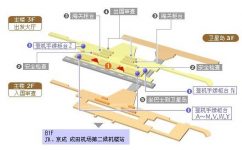
Successful Application of RFID Technology in Narita Airport, Japan
[ad_1]
With the advancement of new technologies, we are enjoying more and more conveniences brought about by the new technological revolution, and air transportation is no exception. The rapid advancement of aviation technology has made the earth more and more flat.
However, we can see various checkpoints everywhere in the airport terminal. First, check passports or ID documents; secondly, check-in counter check-ins; then, security checkpoints for departing passengers; and finally there may be check-in gates here. Together monitoring and inspection. Since the 9/11 incident, airports around the world have increased their security checks. Some US airports have installed technologies such as iris check and fingerprint identification to prevent unrelated persons from entering the quarantine area. The terrorist attack on the airport in the UK prevented various liquids from being carried on the plane.
For the airport, it faces the contradiction between security and convenience. How to establish a precise balance between the two is what it thinks about day and night. For passengers, what they want is very simple-fast and convenient. More checkpoints means more trouble. We can imagine that due to the increase in time for the security check process, passengers will have a corresponding increase in time in the terminal. The resulting social welfare and personal economic losses may not be a small amount.
This article mainly introduces the electronic airport project of Narita Airport in Japan. As Japan’s most important international hub, it is also under pressure. How can we effectively resolve the contradiction between security and convenience? Through the electronic airport project, Narita Airport is working hard to find a solution.
“Electronic Japan” Strategy
The airport was put into operation on May 20, 1978, with a total of two runways. In the 2007 fiscal year, the passenger throughput reached 35.6 million passengers and the cargo throughput reached 2,211,826 tons. The airport has two terminal buildings. T1 South Tower is mainly for Star Alliance and All Nippon Airways; T1 North Tower is mainly for SkyTeam; T2 is for oneworld and JAL. The airport brings together members of major global aviation alliances, mainly to help airlines carry out cooperation and transit services smoothly.
If we want to mention the electronic airport project, we must first describe the measures of the Japanese government. It attaches great importance to IT and Internet technology. As early as June 2001, the government announced the “Electronic Japan” strategy, the core contents of which include:
Establish advanced high-speed Internet infrastructure
Establish an advanced education system and human resource database
Promote e-commerce transactions
Improve government work processes and public services
Establish information security and reliability
In January 2006, the government again announced the revised “e-Japan” strategy, “Japan wants to realize the following society: the benefits of IT can be provided to everyone at any time and anywhere.” It is also mentioned in this strategy. Adopting the SPT (Simplified Passenger Process) concept, “establishing the automation of identification and passenger processes, fully optimizing the airport process to make the airport safer and faster.” The government plans to establish a safe and fast airport process in the 2008 fiscal year. , To establish an international mutual recognition process with East Asian countries by the 2010 fiscal year.
The core of SPT is “one-stop inspection”. Passengers’ information can quickly flow through various checkpoints. The development trend of the aviation industry is to simplify these processes through the use of biometric technology, automatic check-in procedures, and electronic travel documents.
Various SPT projects have emerged at the historic moment, but how to establish a dialectical unity in the conflicting areas of security and convenience? Let’s take a look at Narita Airport’s approach.
Practice out the process
As early as the 2002 fiscal year, the airport had already carried out the SPT experiment project, and implemented the iris and facial feature recognition technology experiment through cooperation with Japan Airlines.
In the 2003 fiscal year, the airport cooperated with All Nippon Airways to simplify the process by using facial recognition technology for passengers who used mobile phones to complete the check-in procedures in advance. At the same time, it cooperated with South Korea’s Incheon Airport to carry out international trials for non-Japanese passengers. Can passengers take the corresponding procedures? At the same time, Japanese airlines must find ways to deal with fierce domestic competition. Japan’s Shinkansen connects almost all major cities on the island. This is one of the fastest railway networks in the world, with a speed of up to 300 kilometers per hour, which gives passengers more choices in travel. All Nippon Airways ANA has specially designed the “Skip (skip)” project to allow domestic passengers to skip the check-in process and go directly to the boarding gate. Since 2005, the company has used mobile phone technology to send 2D barcodes or identification chips. Passengers perform information scanning and identification at the security gate, and then scan the information again before boarding the plane.
In these experiments, the airport has specially set up priority channels, and those passengers who have declared their biological personal characteristics and have stored relevant information (including passport information) in advance can be given priority to pass the customs. As far as the airport is concerned, it believes that the time savings brought by it can be used for passengers who have not registered in advance and can increase inspection efforts to further ensure safety. However, the above experiments are limited to the procedures related to airlines and airports, and the passport inspection still follows the traditional procedures.

With the joint efforts of airlines and airports, the electronic airport project is progressing steadily. Here, we must mention the role played by the government, because all kinds of travel documents are officially confirmed and issued. If the documents are implemented electronically, the efficiency improvement brought by them will be obvious.
In fiscal year 2004, the Japanese government began to add IC chips to passports. Since February 2004, the government has vigorously promoted the e-Japan project, clearly stipulating various parameters of the “e-passport”. First, electronic passports were issued among those holding diplomatic passports and IC cards (SPT cards). Under the unified coordination of the Ministry of Justice of Japan, the passport control gates that were originally operated in accordance with the traditional procedures have also been reformed. In this way, all A series of experiments were carried out at the passenger checkpoints involved. Relevant departments of the Japanese government have implemented division of labor and cooperation. For example, the Ministry of Land, Infrastructure, Transport and Tourism of Japan is responsible for the implementation of the “electronic check-in” project; the Cabinet has officially implemented the electronic passport, and the Ministry of Justice is responsible for the implementation of automated passport control procedures.
For Narita Airport, in order to speed up the progress of the experiment, it was first carried out on frequent air travelers, who used self-service check-in counters to complete the check-in procedures, and then used biometric technology to go through the passport check at the automatic gate (Autogate). The Department of Justice introduced the Autogate process in August 2007. This technology is aimed at the ability to quickly pass Autogate with an SPT card (issued by the Ministry of Land, Infrastructure, Transport and Tourism of Japan). During the test, passengers departing from Narita Airport on All Nippon Airways and JAL aircraft participated in this new process. Approximately 2,300 passengers participated in the experiment, and about 70% of the passengers participated in the questionnaire survey. 80% of them said that these new measures can help reduce various processes in the terminal building and save a lot of time.
As we all know, the most important inspection in a passport is to look at photos, but there can be a lot of stealing and changing posts, otherwise we would not see global smuggling. The use of biometric technology will bring the world into a new era of security. The figure below is the flow chart of electronic check-in.

Electronic airport concept
In order to cooperate with the development of the electronic airport project, Airport United Airlines and the ground transportation company launched three experimental projects in 2004:
1. “Empty with both hands” operation experiment: from March 2004 to March 2005, it was a one-year experiment: passengers handed their luggage to the ground transportation company before departure, went through the formalities empty-handed at the airport, and then boarded the plane directly. At the destination station, baggage was collected. During this period, a total of more than 10,000 passengers participated in the experiment and were satisfied with the new process. In the 2005 fiscal year, the airport matched the current empty-handed travel process with the process of the tour group. The goal is that the baggage of the tour group can be directly sent to the hotel where the destination station is staying. Get out of the airport and board the coach, then get off and drag the suitcase to check into the hotel. On the one hand, this process is convenient for passengers. After all, you don’t need to carry your suitcases around the terminal building, you can stroll around the shops. On the other hand, the front page of the traditional airport check-in counter can reduce working hours and shorten the queue of passengers.
2. Electronic tag scanning technology: At present, most luggage tags are paper two-dimensional barcodes. The accuracy of barcode scanning at Narita Airport can generally exceed 90%, but the global average is only about 70%. Radio frequency RFID tags are the solution. As long as the chip is not damaged, the accuracy rate will be as high as 100%. As early as 2002, the Ministry of Transport of Japan established the “Advanced Baggage Operation System Committee” to promote error-free baggage transportation. From April 2004 to December of that year, Narita Airport tested a total of 200,000 electronic tags. In addition to Narita, four international airports participated in the experiment: New York Kennedy, Vancouver, Frankfurt and Schiphol. They all installed corresponding antennas and scanning systems, with an average accuracy rate of 98.84%. Moreover, the transfer of baggage information between airports is also very accurate, which greatly reduces the baggage error rate.
3. Japan-U.S. UHFRFID experiment: During April-May 2004, under the unified and coordinated command of the U.S. Transportation Security Administration, Narita and Hawaii airports experimented with RFID technology using UHF frequencies. Since 2001, Narita Airport has participated in the IATA RFID Working Group (now as a subgroup under the Baggage Working Group). Based on these experiments, Narita Airport submitted various experimental reports to IATA. In the 2006 fiscal year, the airport and Air France cooperated to carry out RFID experiments.
The author summarizes the concept of the electronic airport as follows:

A quieter and easier journey-this is the service that every air passenger wants to get. More efficient, less flight delays-this is the goal that airlines want to achieve. More cost-effective, faster boarding process-this is the wish that the airport wants to achieve. Then let the electronic airport help!
[ad_2]





